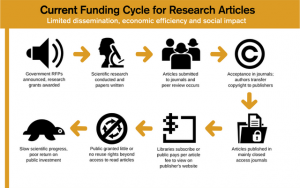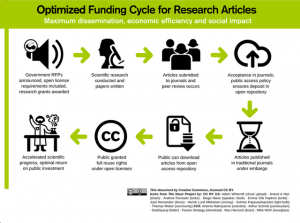
What comes to mind when you think about current procedures for publishing and sharing scholarly work? You might think of the time it takes for an article to go from submission to published document. You may also think of the cost of subscribing to journals associated with your subject area. If the library did not have a subscription, would you be able to afford them?
The Open Access publishing model aims to make scholarly research and publishing more accessible by utilizing digital tools and technologies. Open Access Literature includes the following characteristics:
Compare the graphics below. The one on the left represents the current, traditional model of academic publishing. By contrast, the one on the right incorporates some aspects of Open Access publishing to help maximize access to scholarly work. What do you think the benefits and/or barriers would be in moving to a more open model?

“Research Article Cycles,” by Billymeinke. CC BY 4.0.
Creative Commons. (n.d.). Creative commons certificate for educators, academic librarians and GLAM. https://certificates.creativecommons.org/cccertedu/

“Research Article Cycles,” by Billymeinke. CC BY 4.0.

"Creative Commons: Creative Commons and PBSC" by Danielle Campbell is licensed under a Creative Commons Attribution-NonCommercial 4.0 International License.